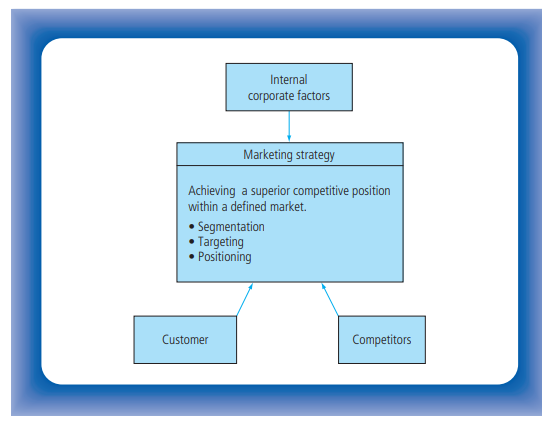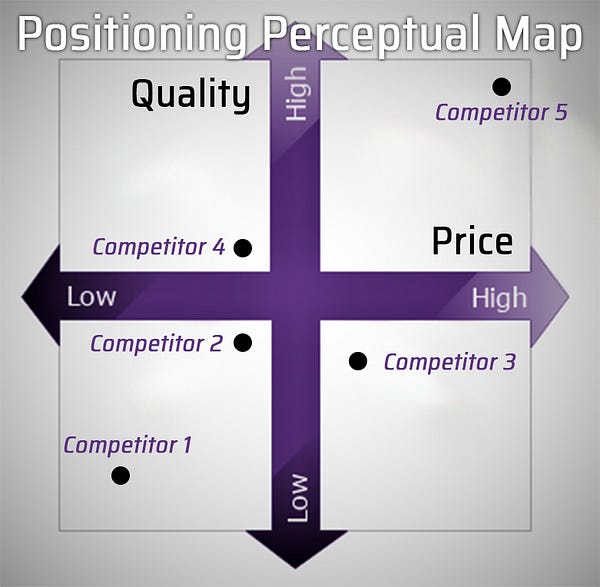A marketing strategy is shaped by a businesses’ strengths, opportunities, and goals, and directs the more specific deliverables of the marketing plan.

Without a marketing strategy, firms are just chucking a product or service out there, hoping it will work.
Hoping there is a customer for it.
Hoping there is something that sets them apart from the alternatives.
Having no strategy is like walking across a desert without a compass or map, hoping good luck will help make it out the other side…
“Marketing strategy is an organisation’s integrated pattern of decisions that specify its crucial choices concerning products, markets, marketing activities and marketing resources in the creation, communication and/or delivery of products… and thereby enables the organization to achieve specific objectives.” (Varadarajan 2010, p. 119)
This article explores marketing strategy and its key components. Five common business orientations are also discussed, and how these influence the marketing strategy and dictates the specific activities of a marketing plan.
What is Marketing Strategy?
A marketing strategy is the overall ‘game plan’ for a business of implementing and reaching marketing-related goals. Focused and achievable; the strategy contains the major objectives, purpose and goals, as well as essential policies and plans for reaching those goals. It is forward-looking, focused on major decisions that affect the long-term direction of the business. It is unique to each business; dependent on their offering, resources, competition and target customers.
This strategy outlines how a firm interacts with the market and its customers. Objectives must consider what a business does well and what they are not doing well, to improve their performance.
In simple terms, marketing’s goal is to reach prospective consumers and turn them into customers, or to retain existing customers. To achieve this, a firm must have a deep understanding of their market and the needs and wants of customers. Their marketing strategy is the link between them and their potential customers.
The importance of a marketing strategy
If a firm does not have a marketing strategy, it can lack direction. Marketing that is not producing results waste money and the firm lose customers that do not know their brand exists. In an increasingly competitive marketplace, firms must make strategic decisions to increase the chances of making the right decisions.
“(A Marketing Strategy is) essentially a formula for how a business is going to compete, what its goals should be and what policies will be needed to carry out these goals.” (Porter, 1980)
A marketing strategy defines a firm’s plan to improve its performance, accounting for its unique challenges and opportunities. Firms produce their strategy by matching their goals, key resources and core capabilities, with external opportunities and trends, and the consideration of the possible risks they face.
Corporate objectives and strategy transformed into a competitive market position through differentiation and meeting customer need more effectively than competitors. Marketing defines how a product or service provides value to customers.

What is the difference between a marketing plan and marketing strategy?
The marketing strategy guides a marketing plan by outlining the firm’s vision, direction and goals. A marketing plan outlines the practical details of specific and defined marketing actions, activities and tactics to reach those goals. A marketing plan aims to make the strategy a reality.
Marketing strategy is the ‘big picture’ and has a longer timeline than an individual marketing plan, as it contains key business elements such as branding and their unique value proposition. A marketing plan contains the details of individual campaigns, which could be over a brief period such as six months to a year.
“Strategy decisions and actions… concerning a firm’s desired goals over a future time period, and the means through which it intends to achieve them including selecting target markets and customers; identifying required value propositions; and designing and enacting integrated marketing programs to develop, deliver, and communicate the value offerings.” (Morgan, Whitler, Feng & Chari, 2019)
Creating a marketing strategy
Formulating a marketing strategy can be a daunting process, even for an experienced marketer. How do you know if your strategy is going to work? To maximise their effectiveness, firms should use the following three co-ordinated steps when creating their marketing strategy:
1. Evaluate the situation, including internal and external environments. Any competitive advantage should be the basis for a marketing strategy, but it still needs to match customer demand. Market research helps to understand the wider business environment and define specific customer needs and identify opportunities.
2. The next phase is the formulation of the strategy that matches products/services with customer segments and outlining specific marketing plans for reaching these target customers.
3. The final phase is the implementation of the marketing mix activities that provides a competitive market position and the set of actions necessary to put the plan in place to reach the firm’s goals.
Key components of a marketing strategy
The goal of marketing is to align a businesses’ strengths and capabilities with customer need. Their value proposition and any competitive advantage should be the foundation of their marketing strategy. These internal factors become important components of a marketing strategy and brand communications. Other key tools and techniques that help guide a marketing strategy through understanding and meeting customer needs are segmentation, targeting and positioning.

Segmentation
Market Segmentation is the act of breaking down a market and grouping together customers who share similar characteristics, behaviours and attitudes. This process helps businesses to understand their customer needs, optimising their marketing, advertising and sales. Creating buyer personas is part of the segmentation process; these are fictional representations of the customer types in your chosen market segment, to illustrate their different personality traits. This process helps match customer wants and needs with your businesses’ ability to satisfy them.
Targeting
Targeting focuses all marketing efforts on a defined group or groups of people called a target market. The selected market segments share common characteristics and interests, so are likely to respond similarly to the marketing material. Because advertising and other marketing strategies focus solely on a target market, marketing becomes more affordable, efficient and effective at generating customer leads.
The targeted customers can be based on existing customers or might be groups of people who overlooked by the competition. If they are profitable, this then presents an opportunity, but it should be long-term to build relationships with customers.
“The marketing strategy lays out target markets and the value proposition that will be offered based on an analysis of the best market opportunities.” (Kotler & Keller, 2012)
Positioning
Firms use positioning to communicate their value proposition and create an image of their brand, product or service, in the minds of target customers. This position is relative to competitors, defining how a brand is unique and how it provides a distinct benefit to customers. Marketing communicates this market position, influencing customer perceptions. Before determining their position in the market, firms decide on a segment of the market that they want to target.
Business Orientations
A firm’s business orientation is their overall strategic organisational focus, which also dictates its marketing strategy. There are five main orientations: production, product, sales, market and societal. This orientation should be based on the strengths of the firm.
Production orientation
A firm with a production orientation focuses on efficient production as its key performance indicator. The key concern is on mass production, the economy of scale (high volume), cost control and meeting production schedules.
A production orientation does not use customer needs or desires to guide their strategy but instead focuses on producing high-quality products as cheaply and quickly as possible. This approach assumes that if you create good products at an affordable price, customers will purchase them, regardless of whether it meets their every need.
Product orientation
Although it sounds similar, a product orientation is vastly different from a production orientation. Instead of focusing on producing a product cheaply, motivation is product development and innovation to continuously improve products to stay ahead of the competition. The idea is that the products are of high quality, so they should sell themselves. Sometimes this means that a firm must try and find a market for a product, as opposed to creating a product for the needs of a market.
Sales orientation
Sales volume is the focus of a sales orientation. Often these firms employ a large salesforce, and focus on short-term sales targets, instead of a long-term strategy. Firms might implement this strategy after a production orientation, to move stock that did not sell as well as expected. Companies concentrate their resources on marketing and sales instead of customer needs. They are a means to an end.

Market orientation
Understanding and meeting customer needs is the basis of market orientation. Also called a customer orientation, being responsive to customer needs is the key objective. Customer demand becomes the focus for resources, to be able to supply what the market wants. Understanding the marketplace comes before any production or marketing. If a firm moves its marketing strategy to a market-based orientation, it often requires fundamental changes in the organisational structure. A market orientation also considers what the competition is doing as well as a focus on building long-term relationships with customers.
Societal orientation
The consideration of society’s long-term interests and doing ‘the right thing’ is the focus of a societal marketing orientation. This philosophy dictates that the environment and society become a consideration for marketing decision-making before customer wants or the company’s requirements. Ethical considerations come first, focusing on the impact the firm and its products have on society and the wider environment.
This article has explored what a marketing strategy is and how its key components segmentation, targeting and positioning direct a marketing plan and its specific activities.
The five common business orientations production, product, sales, market and societal were discussed and how they influence a businesses’ marketing strategy










